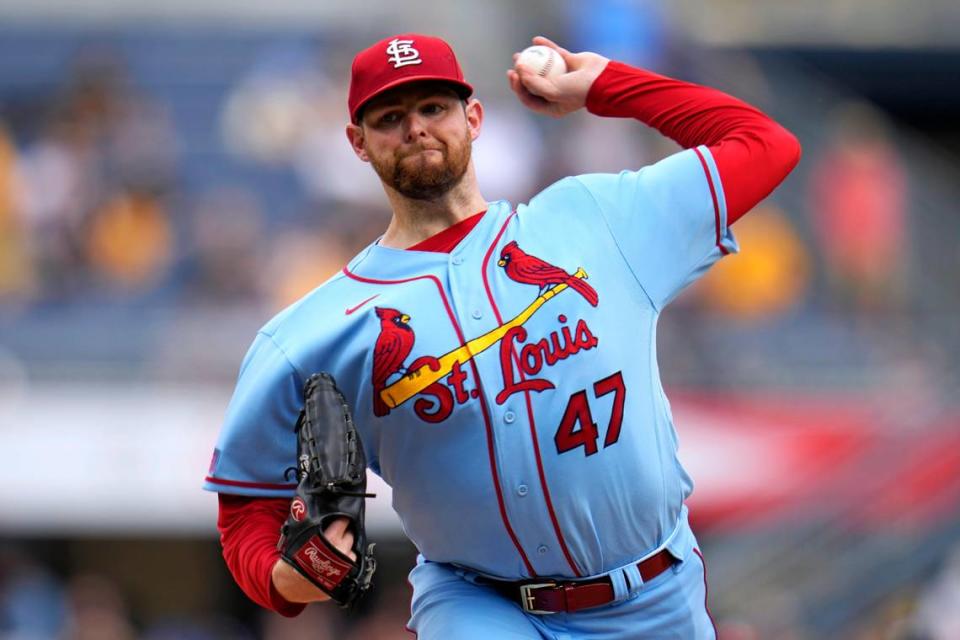How last-place St. Louis Cardinals could benefit from being sellers at MLB trade deadline
“I don’t anticipate us doing that at all,” Cardinals President of Baseball Operations John Mozeliak told Jim Hayes of Bally Sports Midwest on May 29 in reference to the possibility of the team acting as sellers at the trade deadline.
“I hope we’re actively trying to get better come July than looking to move talent,” he said this week to The Athletic’s Katie Woo, after postulating that, at the moment, the team intends to be “holding.”
In the span of 10 days, and near the conclusion of a dreadful 1-5 road trip to Pittsburgh and Texas, already the goalposts have shifted.
Since MLB’s trade deadline has shifted into the modern concept of buyers and sellers, the Cardinals have perhaps never been on the “seller” side of the ledger. The closest, perhaps, was in 2018, when Tommy Pham and Luke Voit were flipped for younger players in an attempt to clean up roster redundancy.
Those deals returned players who helped almost immediately: Giovanny Gallegos (for Voit) was arguably the club’s most important and effective reliever within a year and Génesis Cabrera (for Pham) quickly displayed a lively arm and the ability to provide real help from the left side of the bullpen.
Since, though, the team has been content to let their departing free agents walk, receiving draft pick compensation for Marcell Ozuna but otherwise letting natural roster churn take its toll. What would it look like if 2023 took a different path? If the last place Cardinals don’t significantly improve their place in the standings and are languishing close to a double-digit deficit for a playoff spot, how much could they shake up the market?
Put simply: A lot. With every expectation the Angels will hold on to Shohei Ohtani and the Phillies won’t be able to part with Aaron Nola, the Cardinals would have arguably the two best starting pitcher rentals on the market, allowing themselves to benefit from the squeeze that they so often cite as a barrier in their own improvements. They also would have some of the most appealing bullpen arms available, and after the Aug. 1 deadline, could see themselves rocketing up the national prospect rankings.
Five Cardinals are set to hit free agency at the end of the season, not including Adam Wainwright who’s headed for retirement: Starters Jack Flaherty and Jordan Montgomery and relievers Jordan Hicks, Chris Stratton and Drew VerHagen.
Of those five, only Stratton figures to be a strong candidate to be on the team in 2024. His work in the middle of the bullpen mix has been strong, and reliable relievers are hard to come by. For a team that figures to reload rather than tear down, exploring a modest extension would be a logical move.

Will Flaherty be a Cardinal in 2024?
None of the other four, though, would seem likely to stay in St. Louis through the winter. Flaherty, perhaps, might come to some middle ground between his potential highs and the pitfalls of his lows, but the Cardinals have yet to show the willingness to go to the sort of heights in the market where Flaherty could reach.
Since his disastrous start May 4, Flaherty has averaged nearly six innings per outing with an ERA just north of two; maintain that for the rest of the season, and he could be a $100 million free agent.
Because of his volatility, though, Flaherty might be the most important pitcher of the group to trade. With the qualifying offer set to be around $20 million, there would be a real possibility of Flaherty taking the offer and simply walking to free agency next winter, ahead of his age 29 season. That buys the Cardinals a year, but costs them an opportunity.
Montgomery, meanwhile, also will seek a nine-figure deal this winter, but will pitch next season at 31. His representatives at the Boras Corporation have previously represented three players who accepted qualifying offers, but all three — pitchers Hyun Jin Ryu and Jeremy Hellickson and catcher Matt Wieters — had significant health issues before they hit the market. Montgomery figures to get there healthy.
More attractive trade commodities
If the Cardinals opt to hold Montgomery, they’re likely to receive draft pick compensation when he departs. That cuts some risk on their end but adds it on his; likely he’d prefer to be traded than to hit the market with the qualifying offer millstone around his neck.
Hicks would quickly become one of the most prized relievers available on the market and seems unlikely to return next season regardless. Ryan Helsley, who lost his arbitration hearing to the club this summer, has two more years of team control but would never have higher value. Paul DeJong is also likely to be a free agent this winter but carries a buy out of two team options; to trade him would still seemingly require an outlay of cash for only a modest return.
The Cardinals, clearly, have no appetite for a teardown, and there’s no reason to think they should. The hole they dug at the start of the season, though, continues to deepen. And without a swift change of pace, there’s little reason to believe they’ll be able to find their way out. There’s every reason to believe they would benefit from surrendering to the realities of the marketplace.

 Yahoo Sports
Yahoo Sports 